Types of Power Washer:
Over recent years, power washers have become much more affordable and many of the large DIY sheds sell smaller models for around £100, but there are many different types that may, or may not, be suitable for use in the maintenance of paving.
All of the 'powered' power-washers we have seen are capable of dealing with the majority of patio cleaning jobs; the so-called 'power-washers' that rely purely on mains pressure are, in our opinion, nothing more than glorified water-pistols, and the same effect can be achieved by placing a thumb over the end of a hose. For larger jobs, commercial cleaning operations and for professionals, one of the larger, diesel-engined machines generating pressures of 2500 psi or greater may be a better choice than the small, lightweight electrically powered units.
Site reader, Rob Longworth, passes on his thoughts about smaller, DIY models.....
"When buying a pressure washer for cleaning your patio, don't be fooled by the cheap ones often sold in supermarkets, some quoting very high pressures of say 150bar and for under £100. What is more important is the quality of the pump (you want a 'brass head') and the amount of water it can shift in an hour. A cheap one I bought for about £60 lasted for about two years; but in reality this was the odd small car cleaning job and a couple of 4+ hour shifts cleaning the paved areas from front to back. The hose gave way first, but shortly after buying a replacement one, the pump started to sound worse and worse until the inevitable drop in pressure, then a 'pop!', then a trip to the tip.
I did lots of research and settled on a well-known brand (think chainsaws) for just over £200 (heavily discounted). Looking back, the cheap one was appalling. The pump was so loud and sounded 'tortured', like metal scraping on plastic. It took an absolute age to clean any area, although the results were satisfactory (the backache wasn't though).
The replacement one I got is very quiet, more akin to a generator humming away, and came with a nozzle that has a sort of loose 'eyeball' that the water comes out of in a spinning cone shape. This gives a more even clean than a flat spray and is a lot more powerful and quicker. I did the whole front patio in about 30 minutes where the other one took nearly two hours.
Some may frown, but power washers are also useful for finding (and hence removing!) loose mortar and weeds between your paving slabs, ready for re-filling in one go."
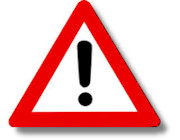
It should be noted that some concrete paving manufacturers and natural stone suppliers have started to include "escape clauses" in their literature, in which they state that they do not recommend the use of power washers on their products. This has come about because some of the bigger power washers are capable of blasting apart some paving materials, notably those with a low cement content (ie, the so-called 'budget' products), some wet-cast decorative patio flags/slabs , and some of the less competent natural stone .
Any paving damaged by pressure washing is highly unlikely to be replaced by the manufacturer - they deem it not to be 'fair wear and tear'.
If you're unsure about whether a particular paving is capable of withstanding the jet of water from a power washer, test a small, discreet area first.
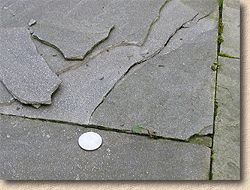
This is especially important with wet-cast pavings (typically patio flags) which are not as tough as pressed pavings ( pcc flags or block paving ). Clay pavers and many natural stone flags are usually capable of withstanding a typical power washer jet, but extra care should be taken with sandstone flags of a laminar nature - the force of the jet can, in some cases, blast off individual laminae (layers).
Using a Power Washer:
Power-washing will not remove all stains; oil needs to be removed with a special oil-cleaning compound, cementitious material has to be removed by mechanical and/or chemical action, and rust can sometimes prove impossible to shift. Power-washing will not undo the effects of UV fading of concrete dyes, or the bleaching of some limestones , but it can make the most of what colour remains, by removing dirt, detritus and surface vegetation, revealing the natural beauty of the paving beneath.
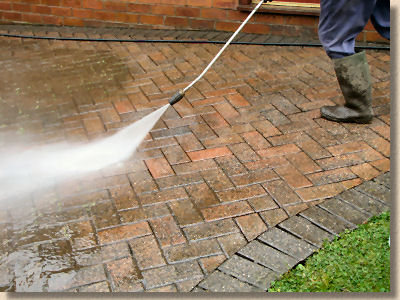
Cleaning paving with a power washer is a relatively simple and straightforward process. If the power washer has the attachment to add detergents etc., this can be used to add a specialist paving cleaner, Jeyes Fluid, degreasers etc. to the power-washing process.
Other than oil-removal agents , we rarely use any detergents, unless specifically requested to do so by the client, as we find they add nothing to the cleaning process other than cost. Try to avoid the acid-based cleaners as they work by chemically reacting with the surface of the paving. This can etch away a very thin surface layer of concrete products and may discolour some natural stone . It often proves detrimental to the paving with repeated use.
Firstly, sweep the area with a stiff brush to remove any loose material on the surface that might be propelled as a missile by the jet of water, potentially injuring someone, smashing a window, damaging paintwork or even abrading the paving itself. Protect any vulnerable items by covering them with, for instance, a sheet of builders' polythene (visqueen) or, better, still, move them out of the way altogether. Park the car somewhere else, if cleaning a driveway.
Cleaning:
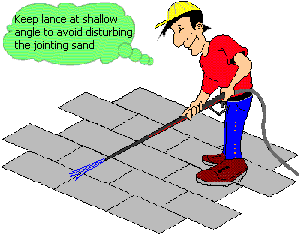
Keep the lance at a shallow angle to the paving, ideally not more than 30 degrees from the horizontal, to prevent the force of the water removing the jointing material from the paving. This is especially important with block or brick paving, which rely on the jointing sand for structural integrity. Any dislodged jointing material must be replaced.
The head of the lance should be 150-300mm from the paving, and the nozzle adjusted, if possible, to produce a 'fan' of water, rather than a point jet. Gilmour has many nozzles that are built specifically for power cleaning.
It's best to work in a steady, systematic manner, thoroughly cleaning one section of paving at a time and then progressing onto the next unit or section, rather than aimlessly squirting the water jet over a general area of paving and hoping for the best.
Clean one brick or one flag, and then move on to the next, gradually working your way through the job. Willy-nilly, unstructured spraying of the paving results in the sort of finish shown opposite - it was probably better looking before the so-called cleaning job!
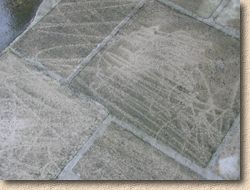
Progress is slow - even with a large commercial power washer, cleaning a square metre of paving in less than a minute is the exception, rather than the rule, and with a typical homeowner's machine, a cleaning rate of 3-5 minutes per square metre would be about the average. Allow 10-20 minutes to set up the cleaning job, and 20-30 minutes to pack away the kit and generally tidying up after completion, and cleaning even a 30m² patio is a full afternoon of a job, not something that can be knocked off in an hour before the footy starts.
Conclusions:
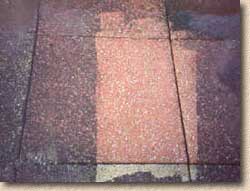
Power-washing is particularly effective at removing mosses and algae that seem to thrive on certain types of paving, most notably 'textured' patio paving and clay brick pavers. We find that the addition of Jeyes Fluid tends to inhibit the return of this type of vegetation for a short time, whilst not affecting the pavement surface. Certain quality sealants are also reputed to inhibit or prevent algal growth, but are an expensive way to eliminate a minor problem.
